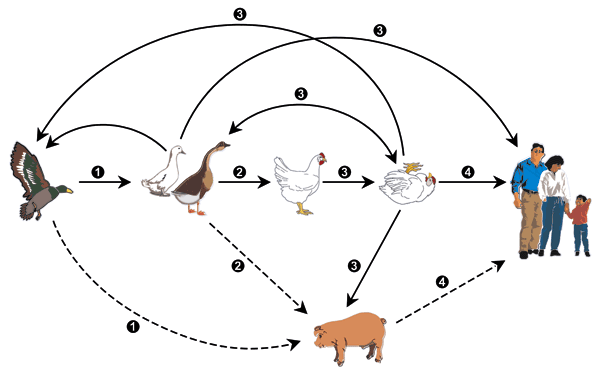Volume 12, Number 1—January 2006
THEME ISSUE
Influenza
Overview
H5N1 Outbreaks and Enzootic Influenza
Figure 1

Figure 1. Emergence of H5N1 influenza virus and control options. A nonpathogenic H5 influenza virus is believed to have spread to domestic ducks and geese, then to domestic chickens. In chickens, the H5 virus became highly pathogenic before it was transferred back to domestic ducks and geese. The highly pathogenic H5 virus reassorted its genome with those of other influenza viruses in aquatic birds, and the resulting viruses spread to domestic poultry farms, humans, and occasionally to pigs. These viruses acquired mutations in their PB2, HA, NA, and NS genes that made them lethal to domestic and wild waterfowl and humans. Solid lines, transmission demonstrated; dotted lines, transmission postulated but not demonstrated. Multiple opportunities exist for control of highly pathogenic avian influenza: 1) prevent contact between wild and domestic poultry by use of screened poultry houses and treated water; 2) prevent contact between domestic waterfowl and gallinaceous poultry by use of screened houses and treated water and by exclusion of waterfowl from "wet markets"; 3) eradicate H5/H7 influenza viruses from gallinaceous poultry by culling or the use of vaccines that prevent disease and transmission; 4) prevent contact between poultry, pigs, and humans and make vaccines and antiviral drugs available.
1Since this article was written, the H5N1 influenza virus has continued to spread in migratory birds to Turkey, Croatia, and Romania. The global spread of this H5N1 in migratory birds and domestic poultry is inevitable. The question is, "When will it acquire sustained human-to-human transmission?"